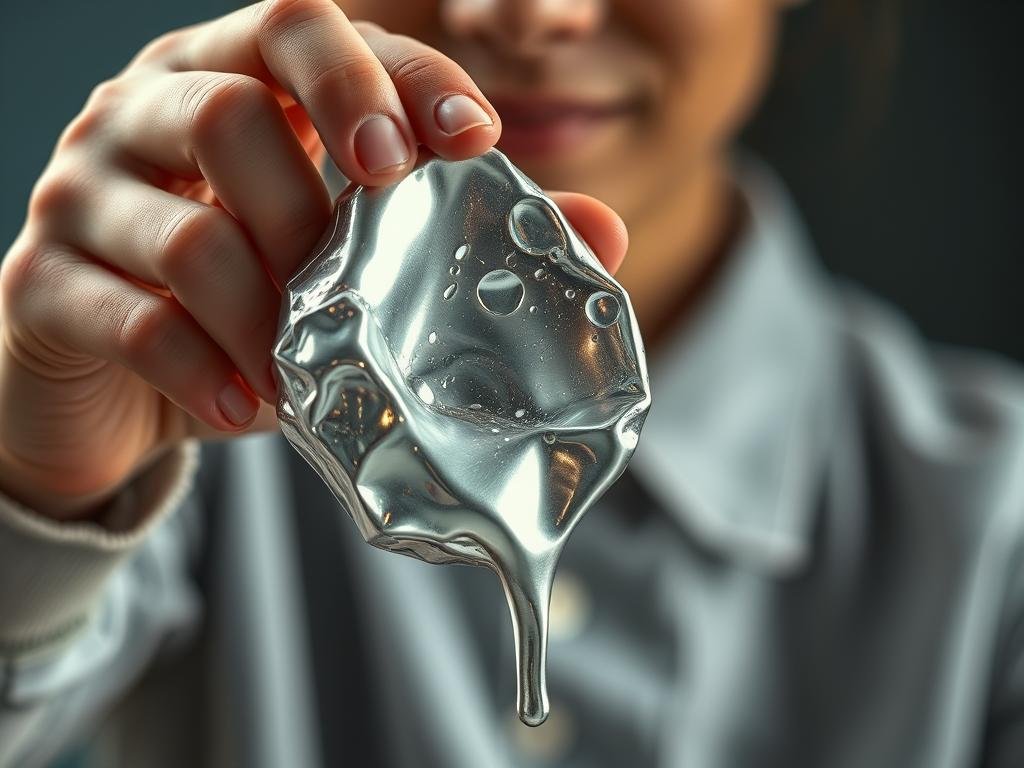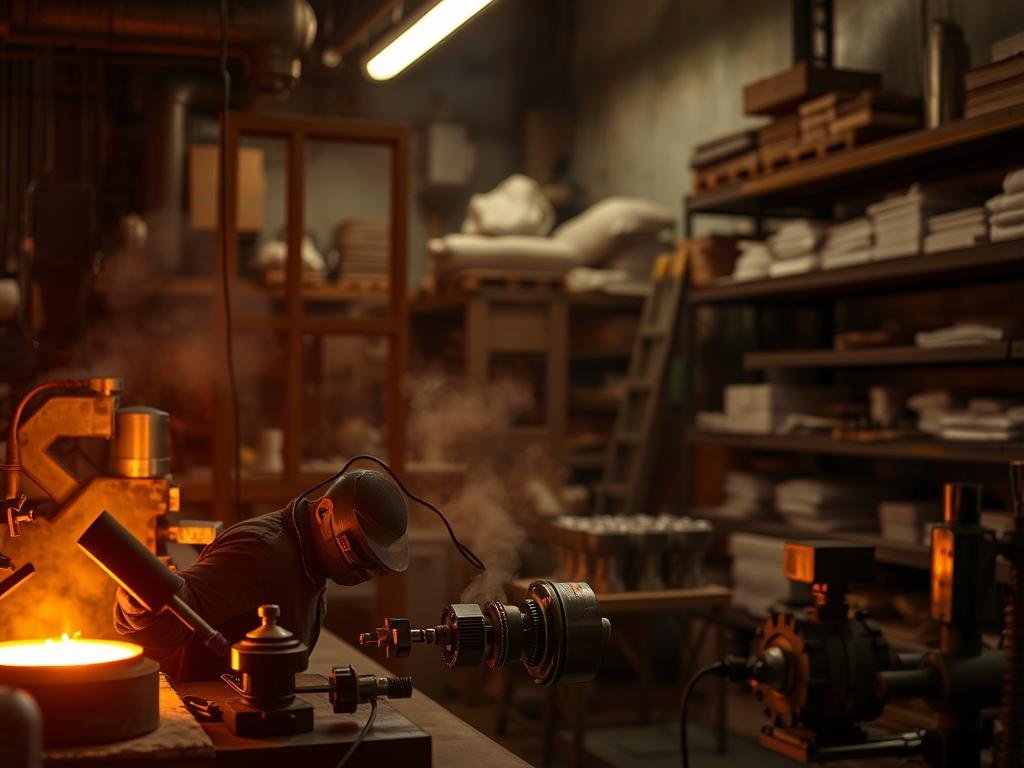The temperature at which a معدن changes from a solid to a liquid state is known as its نقطة الانصهار. Different المعادن have varying نقاط الانصهار, ranging from extremely low to very high temperatures.
Mercury, for instance, has a remarkably low نقطة الانصهار of -38 °F (-39 °C), making it unique among most materials. On the other end of the spectrum, tungsten boasts an exceptionally high melting point of 6,150 °F (3,399 °C).
فهم ال نقطة الانصهار of various المعادن مهم في كل من البحث العلمي والتطبيقات الصناعية، يؤثر على عمليات التصنيع، وتصميم المنتج، واختيار المواد.
Understanding Metal Melting Points
Understanding the melting points of metals is essential for various industrial and scientific applications. The melting point of a metal is a critical property that determines its usability and limitations in different environments.
ما يحدد نقطة انصهار المعدن
A metal’s melting point is determined by its atomic structure and the bonding between its atoms. The strength of these bonds varies among different metals, resulting in a wide range of melting points. For instance, metals with stronger atomic bonds require more energy to break these bonds, thus having higher melting points.
Why Melting Points Matter in Science and Industry
Melting points serve as critical parameters in various manufacturing processes, including casting, welding, and metal forming. They determine the energy requirements and equipment specifications necessary for these processes. Moreover, understanding melting points is crucial for material characterization, developing new alloys, and ensuring industrial safety in high-temperature applications.
| الصناعة | Importance of Melting Points |
|---|---|
| التصنيع | Determining energy requirements and equipment specifications for processes like casting and welding. |
| Scientific Research | Enabling accurate material characterization and development of new alloys. |
| Industrial Safety | Preventing catastrophic failures in high-temperature applications. |
The Metal With the Lowest Melting Point: Mercury
Mercury stands out for its exceptionally low melting point, a characteristic that sets it apart from other metals. With a melting point of -38 °F (-39 °C), mercury is the metal with the lowest melting point. This property makes mercury unique as it remains liquid at room temperature.
Properties of Mercury
Mercury (Hg) is a metal with a distinct set of properties. Its unique electron configuration, particularly the filled 6s orbital, results in weak metallic bonds between atoms. This characteristic, combined with its high atomic mass and relatively weak bonding, contributes to its low melting point.

Why Mercury Remains Liquid at Room Temperature
تساهم عدة عوامل في الحالة السائلة للزئبق في درجة حرارة الغرفة. تؤدي التأثيرات النسبية على إلكتروناته إلى انكماش المدار، مما يضعف الروابط بين الذرات بشكل أكبر. بالإضافة إلى ذلك، تظهر ذرات الزئبق كفاءة ضعيفة في التعبئة في الهياكل البلورية، مما يقلل من طاقة الترابط الإجمالية. تخلق هذه العوامل مجتمعة وضعًا حيث تتغلب الاهتزازات الحرارية بسهولة على القوى التي تحافظ على الذرات في مواقعها الثابتة، مما يبقي الزئبق في الحالة السائلة.
5 Other Metals With Surprisingly Low Melting Points
Beyond mercury, several metals exhibit surprisingly low melting points, expanding our understanding of metal properties. These metals, while not as low as mercury, still have melting points that are considered relatively low and possess unique characteristics that make them valuable in various applications.
Gallium: The Metal That Melts in Your Hand
Gallium is a soft, silvery metal that melts at just 29.76°C (85.57°F), making it one of the metals that can literally melt in your hand. This property, combined with its high boiling point, makes gallium useful in high-temperature applications and as a substitute for mercury in thermometers.

Cesium: Another Ultra-Low Melting Point Metal
Cesium has a melting point of 28.44°C (83.19°F), making it one of the most reactive metals with a low melting point. It’s used in atomic clocks and has potential applications in the field of electronics due to its high reactivity.
Francium: Rare and Unstable
Francium is a highly radioactive metal with a melting point of around 27°C (80.6°F), although its exact melting point is difficult to determine due to its highly unstable nature. Its applications are limited due to its radioactivity.
Rubidium: Reactive and Low-Melting
Rubidium melts at 39.3°C (102.7°F) and is highly reactive, making it useful for applications in atomic clocks and in the manufacture of specialized glasses.
Indium: Versatile Low-Temperature Metal
Indium has a relatively low melting point of 156.6°C (313.9°F), making it easily workable while still being solid at room temperature. Its properties include being soft and malleable, with the unusual ability to “cry” or emit a high-pitched sound when bent. Indium is invaluable in electronics manufacturing, particularly for soldering applications, due to its excellent wetting properties and ability to form reliable bonds with non-metallic materials.
Indium’s transparency to infrared light and excellent electrical conductivity make it essential for producing indium tin oxide (ITO), used in touch screens and LCD displays. Its low toxicity compared to lead has made it an important component in lead-free solders, supporting the electronics industry’s move toward more environmentally friendly manufacturing.
Factors That Affect a Metal’s Melting Point
Understanding what affects a metal’s melting point is crucial in various scientific and industrial applications. The melting behavior of metals is a complex phenomenon influenced by multiple factors.
Atomic Structure and Bonding
The atomic structure and bonding within a metal play a significant role in determining its melting point. Metals with stronger atomic bonds require more energy to break, resulting in higher melting points. The arrangement of atoms and the type of bonding (e.g., ionic, covalent, or metallic) contribute to the overall stability of the metal’s crystal structure.
Impurities and Alloying Elements
The presence of impurities or alloying elements can significantly alter a metal’s melting point. Impurities can disrupt the crystal structure, making it easier or harder for the metal to melt. Alloying elements, intentionally added to modify a metal’s properties, can either raise or lower the melting point depending on their interaction with the base metal.
External Pressure Effects
External pressure is another critical factor influencing a metal’s melting point. Generally, increased pressure raises the melting temperature of most metals, as it becomes more difficult for the atoms to gain enough energy to change from a solid to a liquid state. However, for some metals that contract upon melting (like bismuth and gallium), increased pressure can lower the melting point.
| عامل | تأثير على نقطة الانصهار |
|---|---|
| Atomic Structure and Bonding | Influences melting point through bond strength and crystal structure |
| Impurities and Alloying Elements | Can raise or lower melting point based on interaction with base metal |
| External Pressure | Generally raises melting point, but can lower it for certain metals |
Practical Applications of Lowest Melting Point Metals
Metals with the lowest melting points have various practical applications across different industries. Their unique properties make them ideal for specific uses where high melting points are not required or would be detrimental.
Industrial Uses
تُستخدم المعادن ذات نقطة الانصهار المنخفضة في عمليات صناعية مختلفة. على سبيل المثال، تُستخدم في اللحام وكسبائك قابلة للذوبان في أجهزة الأمان. تتيح هذه المعادن إنشاء أشكال معقدة وتُستخدم في التطبيقات التي تتطلب نقاط انصهار دقيقة.
Scientific Applications
في البحث العلمي، تُستخدم هذه المعادن في التجارب وكعناصر في معدات متخصصة. تجعل نقاط انصهارها المنخفضة منها مناسبة للتطبيقات التي يكون فيها التحكم الحراري حاسماً.
منتجات المستهلك
Consumer products also benefit from low melting point metals. For example, gallium-based alloys are used in thermal interface materials for electronics. Bismuth alloys serve as non-toxic alternatives to lead in fishing sinkers and hunting ammunition. These metals are also found in novelty items, safety devices, and specialized electronics.

Comparing Low vs. High Melting Point Metals
عالم المعادن يشمل مجموعة واسعة من درجات الانصهار، من المنخفضة جدًا إلى العالية بشكل ملحوظ. هذه التنوع ضروري للتطبيقات المختلفة، حيث يسمح للمهندسين باختيار المعادن ذات الخصائص الحرارية المصممة.
الـتنغستن: أعلى معدن ذو نقطة انصهار
الولّاس لديه أعلى نقطة انصهار بين جميع المعادن، عند 3422 درجة مئوية. تجعل هذه الخاصية منه مثاليًا للتطبيقات ذات درجات الحرارة العالية، مثل فوهات الصواريخ ومكونات الأفران.
طيف درجات انصهار المعادن
يمتد الطيف الكامل لنقاط انصهار المعادن على أكثر من ٣،٤٦٠ درجة مئوية، من الزئبق عند -٣٨.٨ درجة مئوية إلى التنغستن عند ٣،٤٢٢ درجة مئوية. يمكن تصنيف المعادن إلى مجموعات ذات انصهار منخفض (أقل من ٥٠٠ درجة مئوية)، ومتوسطة الانصهار (٥٠٠-١٥٠٠ درجة مئوية)، وعالية الانصهار (أكثر من ١٥٠٠ درجة مئوية). فهم هذا الطيف يساعد علماء المواد على تطوير سبائك جديدة بخصائص انصهار مخصصة.
| معدن | نقطة الانصهار (°م) |
|---|---|
| عطارد | -38.8 |
| Tungsten | 3,422 |
| حديد | 1,538 |
As الدكتورة جين سميث، عالِمة مواد، ملاحظات، “تنوع نقاط الانصهار عبر المعادن يوضح العلاقة الأساسية بين البنية الذرية، والروابط، والخصائص الفيزيائية الماكروسكوبية.”
نطاق درجات الانصهار في المعادن هو أحد أوسع نطاقات الخصائص في علم المواد، مما يمكّن المهندسين من اختيار المعادن للتطبيقات المحددة.
الاستنتاج: العالم المثير لخصائص المعادن
استكشاف درجات انصهار المعادن يكشف عن العلاقات المعقدة بين التركيب الذري والشوائب وخصائص المادة. درجة الانصهار، وهي درجة حرارة حاسمة حيث يتحول المعدن من الحالة الصلبة إلى السائلة، تعتبر ضرورية في علم المعادن.
عوامل مختلفة مثل التركيب الذري والشوائب تؤثر على ال نقاط انصهار المعادنفهم هذه العوامل يساعد على تقدير الاستخدامات والخصائص المتنوعة لمختلف المعادن.
- استكشافنا يكشف عن تنوع خصائص المعادن، من الحالة السائلة للزئبق إلى مقاومة الحرارة للتنجستن.
- فهم نقاط الانصهار يوفر رؤى حول القوى الذرية التي تحكم سلوك المادة.
As materials science advances, understanding melting points enables the development of new alloys and composites. This knowledge reminds us that basic material properties can reveal fascinating scientific principles and enable remarkable technological achievements.
